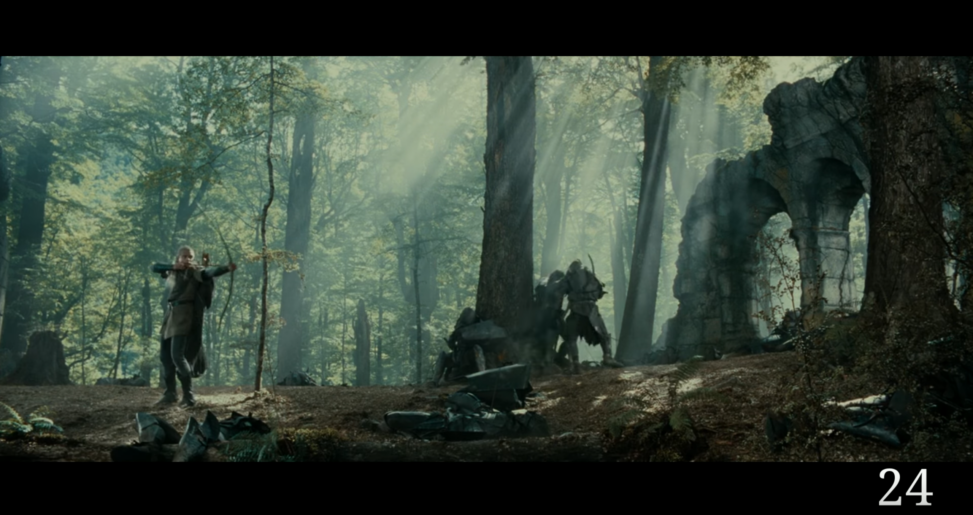Image Attribution: “Assignment 4” by Talia Michel-Isaac is licensed under CC0. (See interactive map)
November 22, 2021
VISA 1500
Talia Michel-Isaac
Terryl Atkins
The framing is in a wide, landscape to fit the ratio of capturing the movements of fighting from across the screen. Also, this is a long shot movement of the camera, as it is showing this character Legolas entirely as well as the environment in which he is fighting off goblins. In this film the Lord of the Rings: The Fellowship of the Ring is cumulated on the reiteration of “The relationship between film (story arc, landscape on screen) and landscape (on the ground, in real life) that is mediated by imagination and practices, is complex and complicated” (Erena, 2020). The result of this is giving the notion of being in this film in “real life”. The goblins are to be the enemy, the evil creatures that are trying to rule the world of their kind. “Goblin” is to be an English term and “Orc” was an Old English term in the previous movies of this Trilogy, but they both are the same in being evil enemies (Milakovic, 2021). This is the 24th arrow Legolas had shot that is visible out of 26 from a YouTube clip I had found on this scene I have chosen. The goblin Legolas is about to shoot is coming from behind the tree, he shoots him before he has even got a chance to fight back. In the shot after this one, it is with a close-up of a fight between Aragorn and another goblin in contact with each other. The violence indicates there is a battle between these characters with (Elf) Legolas and (Man) Aragorn against the goblins. The gender to be in the battleground is that you are only to be a man. As this story is told it is stated that only men can fight in the battle of the war. Ruiz found in a study the role of this film is:
“The world of Middle-earth is undoubtedly male-dominated – at a first perfunctory glance it is only obvious that the Fellowship of the Ring, whose task is to destroy the One Ring that Sauron longs to have to save the world they know from evil, are all male characters: the Men Boromir and Aragorn, the Elf Legolas, the Dwarf Gimli, the Wizard Gandalf and the four Hobbits Frodo, Sam, Merry and Pippin”. The race of Legolas in the film is Sinder Elf, as he can use his bow and arrow to battle, and is known to never miss a shot. The ecology of this scene is in the woods as it is dark with light coming from the top of the trees, and giving a black and white effect, of being the darkness indicates the evil and the light is a sign of hope. Also, two others are fighting close by in this shot of Legolas beside a tree. Legolas is standing in a hero stance as he is about to shoot his arrow at an oncoming goblin who is not in sight but once he releases he is seen falling face forward in the ground in front of him being visible.
This film had done very well as it released $897,690,072 worldwide. The main feeling from this film is with Death and immortality, the deprivation of not wanting to die. Also, the strong relationships between the characters make this film award-winning.
References:
Robert Milakovic, Feb 8 2021, Differences Between Orcs and Goblins in Lord of the Rings (Middle-earth), Fiction Horizon. https://fictionhorizon.com/lord-of-the-rings-middle-earth-differences-between-orcs-and-goblins/.
Beatriz Domínguez Ruiz, Feb 21 2017, J.R.R. TOLKIEN’S CONSTRUCTION OF MULTIPLE MASCULINITIES IN THE LORD OF THE RINGS, ODISEA. Revista de estudios ingleses. https://doi.org/10.25115/odisea.v0i16.295.
Le Heron, Erena. 2020. “Assembling Film-Landscape Relations: Performative Practices of The Lord of the Rings Tours.” New Zealand Geographer 76 (1): 39–48. https://search-ebscohost-com.ezproxy.tru.ca/login.aspx?direct=true&db=ecn&AN=1851004&site=eds-live&scope=site.
